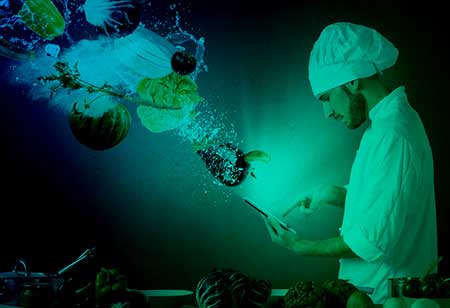Thank you for Subscribing to Food Business Review Weekly Brief
- Home
- Topics
- Alternative Proteins and Plant Based Food
- Beer and Wine
- Canned Beverages
- Coffee And Tea
- Food and Beverage Consulting
- Food and Beverage Financial Service
- Food And Beverages Marketing
- Food Distributors
- Food Ingredients
- Food Sustainability
- Plant Based Food and Beverages
- Seafood Suppliers
- Supplement Manufacturing
- Wine Investment
- News
- Vendor Viewpoint
- CXO Insights
- Conferences
- Newsletter
- CXO Awards
-
Coloring Foods with AR/VR.
AR and VR technology may turn into the most famous and easily used technology for the foodservice industry and end-users.

By
Food Business Review | Friday, January 10, 2020
Stay ahead of the industry with exclusive feature stories on the top companies, expert insights and the latest news delivered straight to your inbox. Subscribe today.

Inventions like augmented reality (AR) and virtual reality (VR) have been around for some time now and gradually approaching many industries. They have altered the way entrepreneurs work and how companies do business. AR and VR will soon turn into powerful tools for several different initiatives that want to find new and creative ways to make their products more appealing and renovate future-oriented businesses.
The entertainment and gaming industry leverages most AR and VR technology. However, its extension to other market segments has high profitability and provides VR/AR vendors with a great prospect. AR and VR will have a significant impact on the foodservice industry.
AR and VR programmers move into the beverage industry as both innovations grow. In this sector, enterprises can use AR and VR to strengthen training for their employees. They can also utilize these technologies to deliver better customer experiences. By inserting AR and VR into training programs, companies in the food services industry can bring down the cost of new staff and make training programs more efficient.
The food industry has its customers' experience, loyalty, and satisfaction. The more convinced the customers, the more successful a business in the food industry. Restaurants can employ this technology to better train their employees to learn about their customers. Also, people can scan food products on even their Smartphones and understand the health benefits and calories.
In addition, AR and VR technologies can undoubtedly help restaurant visitors get their favorite food recipes before ordering them. This allows restaurants to garner more clients and produce significant profits.
Many elegant restaurants also provide their customers with excellent experiences by utilizing virtual reality. These restaurants allow their customers to wear VR gadgets and watch any video about the items present in the restaurant. By looking at these videos, customers' taste buds are spontaneously enhanced.
For example, the Boursin Sensorium sells soft cheese through VR technology. In addition, bars use VR and AR technology to increase customer satisfaction by demonstrating producing alcohol or food supplementing visitors.
AR and VR technology may turn into the most famous and easily used technology for the foodservice industry and end-users.
This empowers restaurants to attract more customers and generate huge profits. Also, these innovations can be used to change the color of certain healthy foods, which are not pleasant or delicious.






